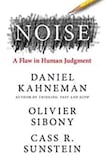
This is the first book I’ve read that has a chief of staff. The customary acknowledgments at the end begin with thanks to the chief. It suggests that the authorial team or subject matter required a co-ordinating presence – a guiding voice to smooth over differences of opinion or interpret complexities.
It is a tribute to the authors that no such difficulties are obvious in Noise. But that is the least of their achievements. A carefully developed argument and the careful marshalling of a wide array of evidence create a penetrating study of an important dimension of human judgment.
Given the status of the authors, such an achievement should not be a surprise. If these social scientists were footballers they would be the team of Ronaldo, Messi and, of course, Harry Kane.
Daniel Kahneman holds the Nobel Prize in Economics. His book Thinking Fast and Slow explains different forms of decision-making with such clarity that it became an unexpected bestseller. Cass Sunstein led the development of Nudge theory, explaining how small changes in how decisions are presented and structured can have a big impact on outcomes. The final member of this triumvirate, Olivier Sibony, is an academic and former management consultant.
Their assembled intellectual firepower explains the differences in outcomes when individuals make decisions on similar issues. This is defined as system noise. It is the “unwanted variability in judgments that should ideally be identical”. This is not a trivial issue – it “can create rampant injustice, high economic costs, and errors of many kinds”.
The opening example of noise demonstrates the human cost and challenge. A prominent American judge, Marvin Frankel, drew attention to the very different decisions by his judicial colleagues. The examples are telling. Two men, both first-time offenders, were convicted of fraud for cashing small counterfeit payments. One was sentenced to 15 years. The second received a sentence of 30 days.
This variation occurs for judgments both about our past and future – “it is the variability in the backward-looking statistics about sentencing decision and underwriting premiums. It is the uncertainty in the forward-looking prediction you make about a particular outcome.”
This is further demonstrated by an insurance case study. Insurance executives are surveyed on how much variation could be expected in expert judgments. A difference of 10 per cent was the most popular response. In fact, an audit of such decisions found that the actual difference was 55 per cent. One underwriter could set a premium for a policy at $9,500. A colleague evaluating the same application could set the premium at $16,700.
Noise argues that the defining features of such difference are that it is unwanted and underestimated. The authors conclude that “wherever there is judgment, there is noise, and more of it than you think”.
A frequent contention is that groups can reduce noise. A “wisdom of the crowd” can emerge with a sufficient number of decision-makers. The authors disagree, due to the impact of “information cascades”. Polarisation can take hold because “when people speak with one another, they often end up at a more extreme point in line with their original inclinations”.
A more effective approach is to search for a common or average result in multiple independently made judgments. This can involve the use of “noiseless rules”, simple mechanical calculations of historical data to develop predictions about future behaviour.
This leads to a startling conclusion. The authors point to research based on the development of statistical models that describe the judgment of individuals. The model outperforms the individual.
A humbling conclusion is reached: “You may believe that you are subtler, more insightful, and more nuanced than the linear caricature of your thinking. But in fact, you are mostly noisier.”
Thankfully, the solution is not our robotic replacement. The concept of “decision hygiene” is introduced. This includes guidance on how to arrange information and develop guidelines on making judgments.
The concept of hygiene illustrates the clinical tone of this book. The risk is that this is at the expense of the diversity of thought and outlook that is central to human agency. Yes, consistency is a strength. but guiding decisions towards a sterile central average can also create vulnerabilities.
Noise is also a dense text – concepts such as mediation assessment protocols should perhaps be left to a very carefree weekend. This is also a narrower topic than earlier publications by Kahneman and Sunstein.
But this is not to diminish the depth of wisdom. The authors carefully develop their proposition, leading the reader to complex conclusions. Perseverance is really worthwhile – this is a great achievement of learning and communication.
Judge Frankel, in his efforts to introduce judicial consistency, argued for the use of “computers as an aid toward orderly thought in sentencing”.
This book makes that prospect a little less likely.
Paschal Donohoe is the Minister for Finance and president of the Eurogroup









